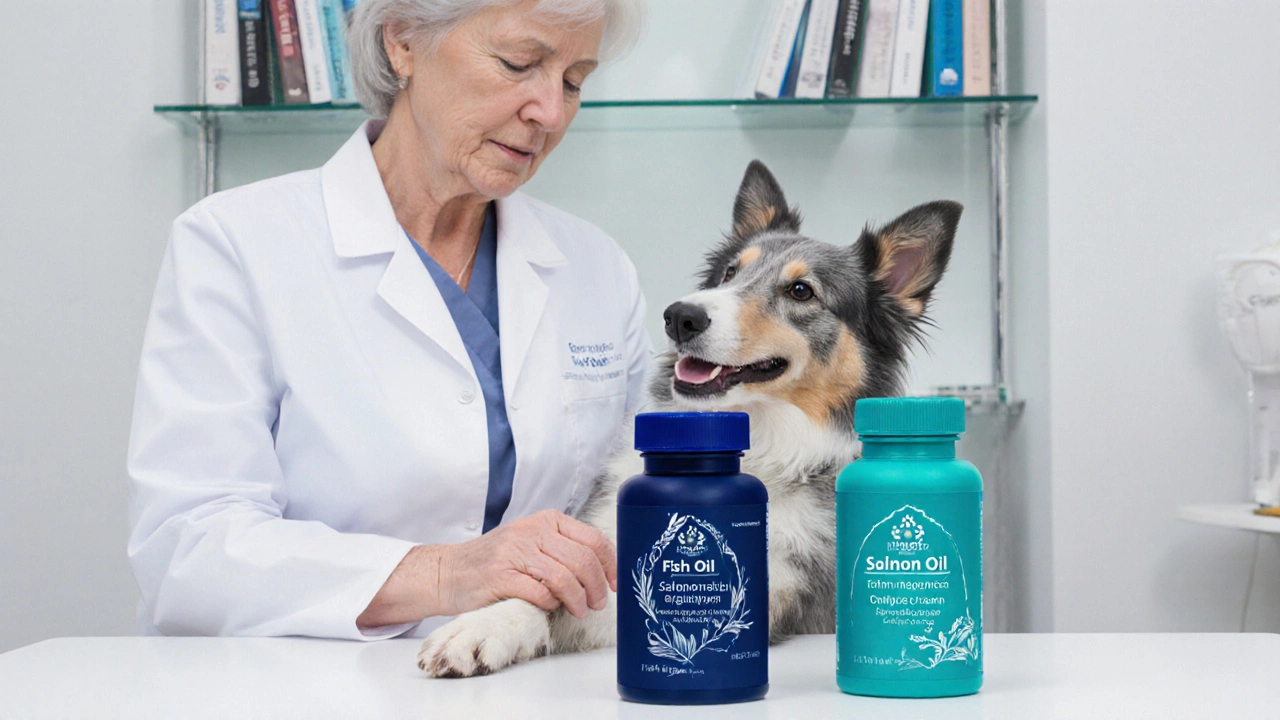Fish Oil vs Salmon Oil Comparison Tool
Compare Benefits
Select your dog's needs to see which oil is better:
Quick Summary
- Both fish oil and salmon oil are rich sources of omega‑3 fatty acids (EPA and DHA) that support skin, coat, joints, and heart health in dogs.
- Salmon oil typically contains a higher proportion of DHA, which is especially beneficial for brain and eye development.
- Fish oil from smaller, cold‑water fish often has a better EPA‑to‑DHA ratio, making it more effective for anti‑inflammatory benefits.
- Purity matters: look for products certified for low mercury, free‑radical oxidation values <10meq O₂/kg, and third‑party testing.
- Choose based on your dog’s specific needs, budget, and any sensitivities - there’s no one‑size‑fits‑all answer.
When it comes to boosting your dog’s health, the debate usually narrows down to two popular choices: fish oil vs salmon oil. Both are touted for their omega‑3 content, but the nuances matter, especially if you want to see real benefits without unnecessary risks.
Below we break down the science, practical considerations, and how to pick the right supplement for your canine companion.
What Are Fish Oil and Salmon Oil?
Fish oil is a liquid extract derived from the tissues of oily, cold‑water fish such as anchovies, sardines, and mackerel. It’s prized for containing the essential omega‑3 fatty acids eicosapentaenoic acid (EPA) and docosahexaenoic acid (DHA). The raw material often undergoes molecular distillation to strip out contaminants like mercury and PCBs.
Salmon oil comes specifically from the flesh of Atlantic or Pacific salmon. Like fish oil, it supplies EPA and DHA, but the natural DHA levels are usually higher because salmon’s diet is rich in plankton that produce DHA. Salmon oil can be cold‑pressed or rendered, and reputable brands also apply purification steps to ensure safety.
Omega‑3 Fatty Acid Profile: EPA vs DHA
Understanding the two main omega‑3 compounds helps explain why one oil might edge out the other for certain health goals.
- Eicosapentaenoic acid (EPA) is the primary anti‑inflammatory agent. It helps reduce joint swelling, supports heart rhythm, and can calm itchy skin.
- Docosahexaenoic acid (DHA) feeds brain and eye cells. Puppies and senior dogs both benefit from DHA for cognition and vision.
Typical fish‑oil blends from smaller species hover around a 2:1 EPA‑to‑DHA ratio, while salmon‑oil blends tilt toward 1:2 or even 1:3. If you’re targeting joint inflammation, fish oil’s higher EPA may be advantageous. For brain support, salmon oil’s DHA boost is hard to beat.
Bioavailability and Sourcing
Both oils are absorbed efficiently when fed with a meal containing some fat. However, the source fish influences oxidation stability - the tendency of the oil to go rancid.
Smaller fish have naturally lower levels of “pro‑oxidants,” so their oil stays fresher longer, especially when packaged with antioxidants like vitaminE. Salmon oil, being richer in polyunsaturated fats, can oxidize faster if not protected. Look for products that list an “oxidative stability” measurement (often expressed as peroxide value or anisidine value). Values under 5meq O₂/kg are considered fresh; anything above 10 suggests the oil may have begun to degrade.

Health Benefits for Dogs
Regardless of the source, the core benefits stem from the omega‑3s themselves. Here’s how they translate into real‑world improvements for your dog.
- Skin & Coat - EPA reduces inflammation that causes itching, while DHA improves skin barrier function, leading to a glossy coat.
- Joint Health - Studies on canine osteoarthritis show that daily EPA supplementation can lower pain scores by up to 30%.
- Heart Support - Omega‑3s help maintain normal heart rhythm and can lower triglyceride levels, which is especially useful for large breeds prone to cardiac issues.
- Cognitive Function - DHA is a major component of neuronal membranes; senior dogs receiving DHA often perform better on memory tests.
- Immune Modulation - EPA and DHA help balance cytokine production, making dogs more resilient to seasonal allergies.
Potential Downsides & Safety Considerations
Both oils are generally safe, but a few pitfalls can turn a health boost into a problem.
- Over‑dosage - Too much oil adds extra calories, potentially leading to weight gain. Follow the manufacturer’s dosage based on your dog’s weight.
- Oxidation - Rancid oil smells fishy and can irritate the gut, causing diarrhea. Store in a cool, dark place and use within the “best‑by” date.
- Allergies - While rare, some dogs may react to the fish protein residue. Opt for “molecularly distilled” products that remove most protein.
- Drug Interactions - Omega‑3s have mild blood‑thinning effects. If your dog is on anticoagulants, consult your vet before adding a supplement.
Choosing the Right Supplement
Here’s a practical checklist that helps you decide which oil fits your dog’s lifestyle and health goals.
| Attribute | Fish Oil | Salmon Oil |
|---|---|---|
| EPA:DHA Ratio | 2:1 (higher EPA) | 1:2 or 1:3 (higher DHA) |
| Typical Sources | Anchovies, sardines, mackerel | Atlantic/Pacific salmon |
| Oxidative Stability | Usually higher (lower peroxide values) | Can be lower - look for added antioxidants |
| Cost per 100mg EPA/DHA | Often cheaper | Slightly premium |
| Best For | Joint inflammation, heart health | Puppy brain development, senior cognition |
When weighing the options, consider three main factors:
- Specific Health Goal - Joint vs brain support.
- Budget - Fish oil generally offers more EPA per dollar.
- Product Purity - Choose brands with third‑party testing for heavy metals, dioxins, and oxidation.
Practical Tips for Feeding
- Mix the recommended dose into a wet meal or a spoonful of plain yogurt to mask any fishy taste.
- Start with half the suggested amount for the first week; this lets your dog’s digestive system adjust.
- Store the bottle in the refrigerator after opening to slow oxidation.
- Keep a simple log - note coat shine, stool consistency, and any changes in activity level.
When to Consult the Vet
If your dog shows persistent vomiting, an unusual rash, or you plan to add other supplements (like glucosamine or probiotics), a quick vet check ensures there’s no overlap or contraindication. Vets can also run a blood panel to verify that omega‑3 levels are within the therapeutic range.

Frequently Asked Questions
Can I give my dog both fish oil and salmon oil together?
Yes, but it’s usually unnecessary. Combining them just increases the total omega‑3 dose, which can lead to excess calories. If you want the benefits of both EPA and DHA, choose a high‑quality blend that already balances the two.
How much oil should I give my 30‑lb dog?
A common guideline is 500mg total EPA+DHA per 20lb of body weight per day. For a 30‑lb dog, that’s about 750mg. Always double‑check the product’s label and adjust for any additional omega‑3 sources in the diet.
Is salmon oil better for puppies?
Puppies benefit from DHA for brain development, so salmon oil’s higher DHA content can be advantageous. Look for a puppy‑specific formula that includes the right dosage and added antioxidants.
What does a rancid oil smell like?
Rancid oil has a sharp, stale fish odor, often described as “paint thinner” or “metallic.” If the smell is off, discard the bottle - feeding rancid oil can upset your dog’s stomach.
Do I need a separate vitaminE supplement?
Most high‑quality fish‑ and salmon‑oil products already contain added vitaminE as an antioxidant. Adding more isn’t necessary unless your vet recommends it for a specific deficiency.
Bottom line: there’s no universal winner. Pick the oil that matches your dog’s primary health target, verify purity, and stick to the recommended dose. With a little trial and observation, you’ll soon see a shinier coat, smoother joints, or sharper focus - proof that the right omega‑3 source can make a real difference.
